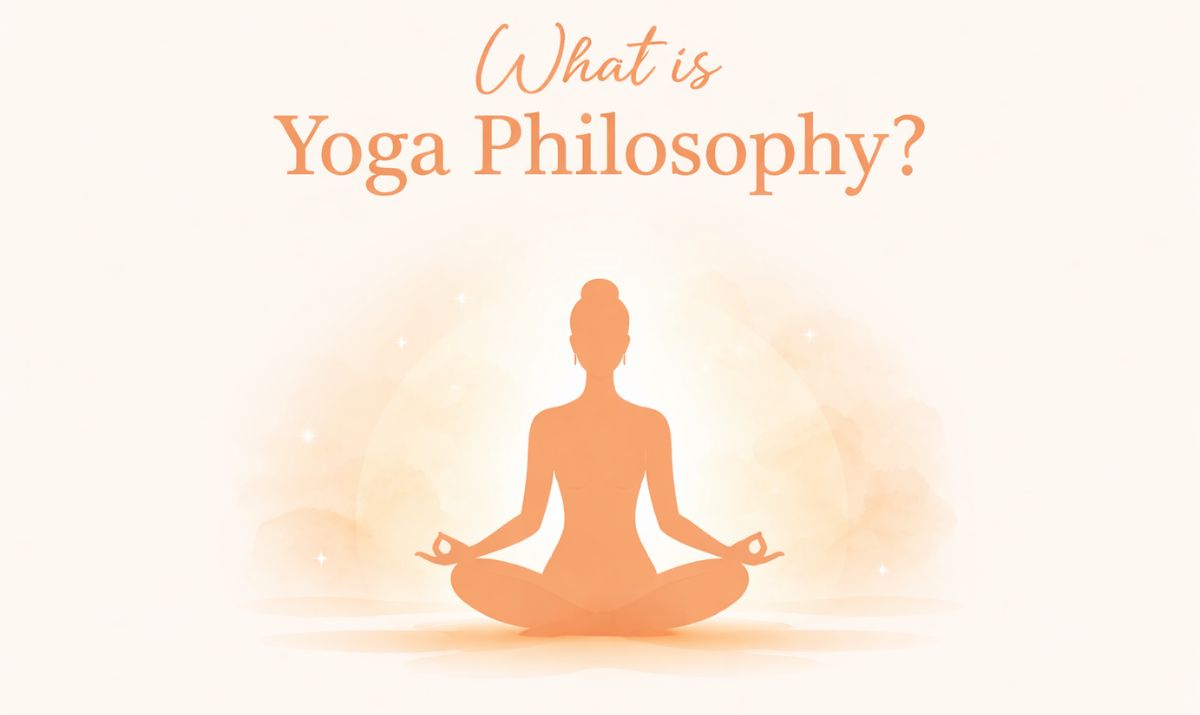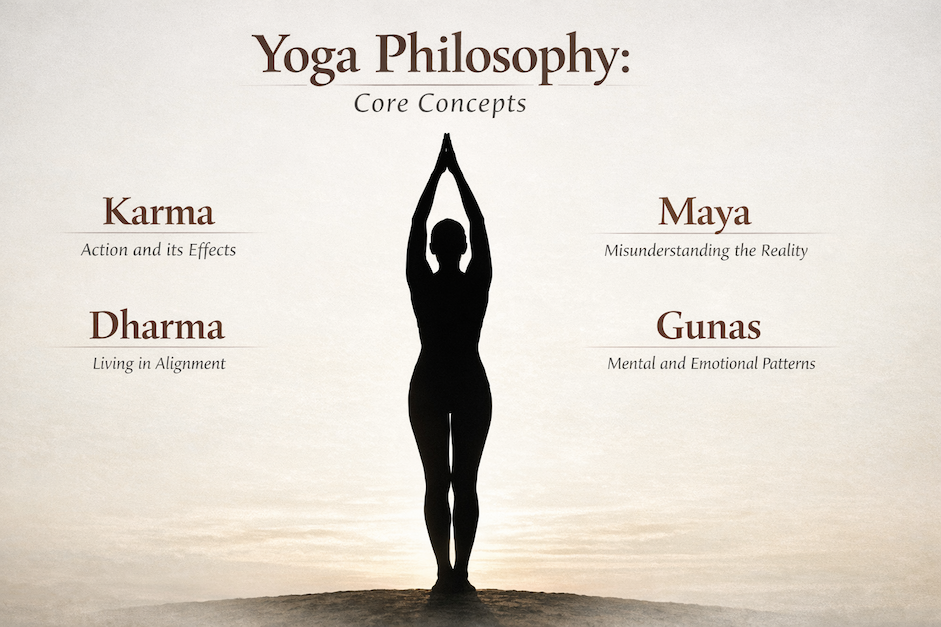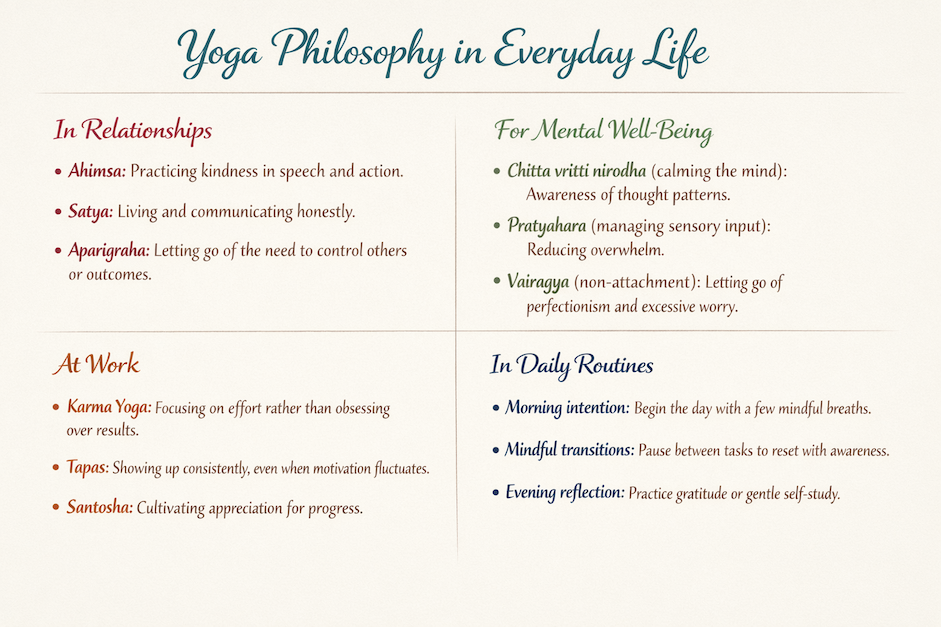

Yoga philosophy is an ancient Indian system of thought that focuses on understanding the mind, reducing suffering, and realizing one’s true nature. It offers ethical guidance, mental disciplines, and meditative practices that support inner peace, self-awareness, and balance in everyday life.
Rooted in classical texts such as the Yoga Sutras of Patanjali and the Bhagavad Gita, yoga philosophy emphasizes the integration of mind, body, and consciousness. Although it includes spiritual insights, yoga philosophy is not a religion. It does not require belief, worship, or conversion, and it can be practiced by people of any faith—or none at all.
Many people first encounter yoga through physical postures, only to later discover that philosophy forms the deeper foundation of the practice. Yoga philosophy explains why yoga works, not just how to practice it. It provides a practical framework for understanding the mind, responding to stress, and living with greater clarity and purpose.
Whether you are new to yoga or looking to move beyond physical practice, this article will guide you through the meaning of yoga philosophy, its historical roots, its main philosophical paths, and practical ways to apply yogic wisdom in everyday life.
One of the most common questions beginners ask is also one of the most important to clarify early: Is yoga a religion, or is it a philosophy?
The short answer is this: yoga is a philosophy, not a religion.
Understanding this distinction helps remove confusion and makes yoga philosophy accessible to people from all backgrounds.
A religion typically involves:
A philosophy, on the other hand, is a way of understanding life. It explores questions like:
Yoga belongs in the second category.
Yoga philosophy offers methods and insights, not commandments. It does not ask you to believe in a particular god, follow rituals, or adopt a new religious identity. Instead, it provides practical tools (ethical guidelines, breath awareness, meditation, and self-reflection) to help you understand your own mind and behavior.
You can think of yoga philosophy as a user’s manual for the mind rather than a belief system.
Yoga originated in ancient India, where it developed alongside traditions that later came to be grouped under labels like Hinduism, Buddhism, and Jainism. Because of this shared cultural and historical background, yoga is sometimes mistakenly assumed to be a religious practice.
However, yoga emerged as a distinct philosophical system, focused on liberation from suffering through self-discipline and insight. While some religious traditions adopted yogic practices, yoga itself does not belong exclusively to any religion.
Yoga philosophy does have a spiritual dimension, but “spiritual” does not mean “religious.”
In yoga, spirituality refers to:
Some people approach yoga philosophy purely as a system for mental health and ethical living, while others explore its deeper spiritual insights.
Both approaches are valid.
At MyYogaTeacher, yoga philosophy is taught gently and respectfully—without religious pressure or complex jargon.
[inline-CTA-1]

To understand yoga philosophy, it helps to look at the ideas that shaped the yogic way of life. At its core, yoga philosophy is concerned with a fundamental human question: How can we reduce suffering and experience lasting inner peace?
Over thousands of years, Indian sages explored this question through lived practice, reflection, and observation of the mind. The result was a philosophy that is both experiential and practical, and still deeply relevant to modern life.
Yoga philosophy originated in ancient India and evolved over several centuries. Rather than being created by a single founder, it developed through oral traditions, disciplined practice, and philosophical inquiry.
Key milestones in this evolution include:
Together, these texts shaped yoga into a complete philosophical system, not merely a physical discipline. Among them, the Yoga Sutras of Patanjali stand out as the most influential text for understanding classical yoga philosophy, making them especially important for anyone interested in yoga beyond postures.
The ultimate goal of yoga philosophy is often described using terms like moksha or kaivalya, which mean liberation or freedom.
In simple terms, this freedom refers to:
Rather than escaping life, yoga philosophy teaches how to live fully while remaining inwardly free.
One of the defining features of yoga philosophy is its view of the human being as an integrated whole.
Yoga teaches that:
This understanding explains why yogic practices work on multiple levels. Physical postures support mental clarity, breath regulation calms emotional patterns, and ethical living contributes to inner stability.
Yoga philosophy introduces several core ideas that explain how suffering arises and how it can be reduced.
Karma (Action and Consequence)
Karma refers to action and its effects. In yoga philosophy, it is not about punishment or reward, but about understanding that every action, thought, and intention leaves an impression on the mind. Practically, karma encourages conscious choices instead of automatic reactions.
Dharma (Living in Alignment)
Dharma means living in accordance with your values, responsibilities, and inner nature. It emphasizes integrity and purposeful action rather than rigid duty.
Maya (Misunderstanding Reality)
Maya describes the tendency to mistake what is temporary for what is permanent. Over-identifying with roles, success, or possessions can create stress and dissatisfaction when circumstances change.
The Three Gunas
Yoga philosophy explains mental and emotional patterns through three qualities of nature:
Understanding these qualities helps practitioners recognize imbalance and cultivate greater mental clarity.
The ideas outlined above form the conceptual foundation of yoga philosophy. Patanjali’s Yoga Sutras build upon these principles, presenting them in a clear and structured framework that continues to guide yoga practice today.
[GC]
When people talk about classical yoga philosophy, they are almost always referring to the Yoga Sutras of Patanjali. This ancient text is considered the most influential and systematic explanation of yoga’s philosophical framework—one that continues to guide practitioners, teachers, psychologists, and meditators even today.
To understand why this text holds such importance, it helps to begin with a simple question: What are the Yoga Sutras?
The Yoga Sutras are a collection of short, aphoristic statements written in Sanskrit. The word sutra literally means “thread,” suggesting that each line is a compact strand of wisdom meant to be reflected upon and explored through practice.
In total, there are 196 sutras, divided into four chapters, or padas. Each sutra is intentionally concise, offering guidance in distilled form rather than a detailed explanation.
For this reason, the Yoga Sutras have traditionally been studied with the support of a teacher who can provide context, interpretation, and practical application—a practice that remains valuable even today.
Patanjali is traditionally regarded as an Indian sage who compiled and organized existing yogic knowledge into a clear and coherent philosophical system. What’s important to understand is this:
This systematic approach is reflected in how the Yoga Sutras themselves are organized.
Each chapter of the Yoga Sutras focuses on a different aspect of the yogic journey, moving from understanding the mind to complete inner freedom.
This chapter defines yoga and introduces the state of inner stillness known as samadhi.
Key teachings include:
Modern takeaway: You are not your thoughts. With practice, the mind can become calmer and more focused.
This is the most practical chapter and the one most relevant to everyday life.
It introduces:
Modern takeaway: Suffering is not random—it has identifiable causes that can be addressed through conscious practice.
This chapter explores the deeper stages of concentration, meditation, and absorption.
It discusses:
Modern takeaway: Deep focus and mindfulness can lead to exceptional clarity, insight, and mental stability.
The final chapter describes kaivalya, or complete inner freedom.
Key ideas include:
Modern takeaway: True freedom comes from knowing yourself beyond roles, thoughts, and conditioning.
Although written thousands of years ago, the Yoga Sutras address challenges that feel unmistakably modern:
For this reason, the Yoga Sutras are often described as an ancient psychology of the mind—one that complements modern approaches to mental health, mindfulness, and well-being.
Understanding these teachings becomes far more meaningful when they are explored with guidance and discussion.
Explore yoga philosophy group classes to understand how these ideas can be connected to real-life experiences and applied in practical ways.
One of the most influential teachings from Patanjali’s Yoga Sutras is the Eight Limbs of Yoga, also known as Ashtanga Yoga. Rather than being a set of steps to “complete,” the Eight Limbs form a holistic framework that supports balanced living—physically, mentally, and ethically.
Together, they explain how yoga philosophy becomes a lived experience, not just an idea.
The Eight Limbs are eight interconnected aspects of yogic practice that work together to reduce suffering and cultivate self-awareness:
This structure shows that yoga is far more than physical exercise—it is a complete philosophy of life.
To learn about the Eight Limbs of Yoga in detail, read this complete guide!
Yoga philosophy recognizes that people are different. Some are naturally reflective, others action-oriented, emotionally expressive, or drawn to meditation and discipline. Rather than prescribing a single approach, yoga offers multiple philosophical paths—all leading toward the same goal of self-awareness and inner freedom.
All paths of yoga philosophy aim to reduce suffering and help individuals experience clarity, balance, and meaning. The difference lies in how that goal is approached.
In practice, most people naturally combine elements from several paths rather than following only one.
Jnana Yoga focuses on wisdom, inquiry, and self-knowledge. It appeals to those who enjoy reflection, study, and asking deep questions about life and identity.
Key aspects include:
Modern application: Questioning habitual beliefs, practicing self-inquiry, and developing clarity through understanding.
Bhakti Yoga emphasizes devotion, love, and connection to something greater than the individual ego. While it can involve traditional devotional practices, it is fundamentally about cultivating humility, gratitude, and compassion.
Key aspects include:
Modern application: Practicing gratitude, finding meaning through service, and developing emotional resilience.
Karma Yoga is the philosophy of selfless action. It teaches that work can become a spiritual practice when performed with awareness and without attachment to results.
Key aspects include:
Modern application: Reducing work-related stress by focusing on effort rather than perfection, and finding purpose in everyday responsibilities.
Raja Yoga is the path most closely associated with Patanjali’s Yoga Sutras. It focuses on mental discipline, meditation, and the systematic training of the mind through the Eight Limbs of Yoga.
Key aspects include:
Modern application: Mindfulness practices, meditation for stress reduction, and improving focus and emotional regulation.
Hatha Yoga works with the body and breath to prepare the practitioner for meditation. Traditionally, its purpose was not fitness but balance—creating physical stability so the mind could become calm.
Key aspects include:
Modern application: The foundation of most contemporary yoga classes, supporting physical health and mental well-being.
Tantra Yoga focuses on working with subtle energy and awareness. It is often misunderstood, but classical Tantra emphasizes presence, integration, and seeing the sacred in everyday life.
Key aspects include:
Modern application: Practices that cultivate deep awareness, such as chakra meditation or guided visualization.
You don’t need to choose just one path. A modern yoga practitioner might:
Yoga philosophy is flexible—it adapts to your temperament, lifestyle, and stage of life.
At MyYogaTeacher, instructors often blend these paths naturally, helping students explore philosophy in a way that feels balanced and accessible.
[inline-CTA-2]

One of the most powerful aspects of yoga philosophy is that it was never meant to stay on the page. These teachings were designed to be lived, helping people navigate everyday challenges with greater clarity, balance, and resilience.
You don’t need to withdraw from society or radically change your lifestyle. Yoga philosophy meets you exactly where you are.
Relationships often trigger strong emotions—attachment, frustration, jealousy, or misunderstanding. Yoga philosophy offers simple but profound tools for navigating these moments more consciously.
Modern work environments often involve pressure, deadlines, and constant mental stimulation. Yoga philosophy provides practical guidance for staying grounded and focused.
Many yogic concepts align closely with modern psychological insights.
Yoga philosophy can be woven into small, consistent habits.
These moments of awareness add up, gradually shifting how you experience daily life.
Svadhyaya (self-study) encourages honest observation without judgment. This might include:
Yoga philosophy also helps identify common sources of suffering, known as the kleshas—ignorance, ego, attachment, aversion, and fear—so they can be addressed consciously rather than unconsciously.
Yoga philosophy is not something you need to master all at once. It is meant to be explored gradually and lived over time. You don’t need prior knowledge, a spiritual background, or years of practice to begin—only curiosity and a willingness to reflect.
Studying yoga philosophy with experienced Indian teachers helps preserve its depth while keeping it practical, clear, and accessible. Rather than memorizing concepts, you learn how to apply them to real situations—stress, relationships, work, and everyday decision-making.
At MyYogaTeacher, you can explore yoga philosophy in ways that suit your learning style:
Yoga philosophy doesn’t ask you to become someone new. It helps you relate to life with more awareness, balance, and ease, starting exactly where you are.
The main philosophy of yoga focuses on reducing suffering by understanding and calming the mind. It teaches that inner peace comes from self-awareness, ethical living, disciplined practice, and detachment from excessive identification with thoughts and emotions. The ultimate aim is self-realization—knowing your true nature beyond the ego.
No. While yoga philosophy originated in ancient India and shares historical roots with Hindu traditions, it is a distinct philosophical system—not a religion. Yoga does not require belief in deities or rituals and can be practiced by people of any faith or none at all.
Yes. Yoga philosophy can be practiced in a completely secular way. Many people use its teachings for stress management, mental clarity, emotional resilience, and ethical living without engaging with spiritual language or concepts.
Yes. Yoga philosophy does not require belief in a specific deity or religious system. People from many backgrounds—including Christians, Muslims, Jews, Buddhists, atheists, and agnostics—practice yoga philosophy by focusing on its universal principles, such as compassion, honesty, self-discipline, mindfulness, and emotional balance.
Absolutely. Yoga philosophy addresses timeless human challenges such as stress, distraction, emotional reactivity, and the search for meaning. Its teachings align closely with modern psychology, mindfulness practices, and mental health approaches, making it highly relevant in today’s fast-paced world.
Begin with simple concepts like mindfulness, ethical living, and breath awareness. Reading beginner-friendly translations of the Yoga Sutras, attending philosophy discussions, and learning from experienced teachers, especially through guided classes or 1-on-1 sessions, can make the journey clearer and more supportive.


Receive personalized guidance tailored to your unique fitness goals, live with a dedicated coach—no credit card required.